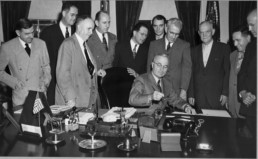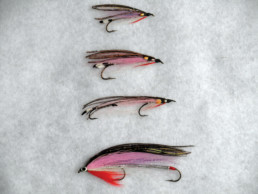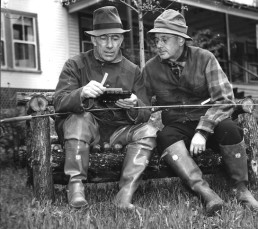by Rhey Plumley
On 5 May 2014, Vermont Governor Peter Shumlin signed into law Bill H. 589, An Act Related to Hunting, Fishing, and Trapping, which included the designation of the Governor Aiken Bucktail Streamer—named for George D. Aiken, Vermont’s governor from 1937 to 1941—as the official fishing fly of the state of Vermont. This is a first for Vermont, as well as a tribute to a highly regarded governor and senator and to Vermont’s historic enthusiasm for fly fishing. Let me tell you the story of the fly and how it came to honor the man.
Fly fishing as a pastime, especially during winter, is full of dreaming, reading, curiosity, and fiddling around with feathers and hair. The Governor Aiken Bucktail, because it’s a pretty fly and catches fish, is one of my favorite fly patterns for landlocked salmon fishing in northern Lake Champlain and its tributaries. The pattern for this fly is referenced in several fly-tying books, going back to Joseph D. Bates Jr.’s Streamer Fly Tying and Fishing1 and later in Stewart and Leeman’s Trolling Flies for Trout & Salmon,2 Leiser’s The Book of Fly Patterns,3 Wilson’s Smelt Fly Patterns,4 and Schmookler and Sils’s Forgotten Flies.5
In his book, Bates mentions that the Governor Aiken Bucktail was popular in the Lake Memphremagog area near the border of Vermont and Québec.6 The pattern he described (also called the “smelt streamer”7), is the American version, dressed by the company Fin, Fur and Feather, Ltd. The Governor Aiken Bucktail is related to the Magog Smelt, a Canadian variation originated by Grier Gulline of the same company.
I tied the fly for myself and for the occasional customer at Classic Outfitters in South Burlington, Vermont, where I was manager. I fished the fly for landlocked salmon in Lake Champlain tributaries, Northeast Kingdom rivers, and streams in the Connecticut Lakes region of New Hampshire. I read about the fly, but nowhere could I find a written history of the Governor Aiken Bucktail or who originated this fly honoring Vermont’s former governor.
Sometime during the winter of 2001–2002, I spoke with Attorney General Bill Sorrell, an occasional fishing partner, whose mother, Esther Sorrell, had been friends with Lola Aiken, Governor Aiken’s widow. He graciously arranged for me to talk to Mrs. Aiken via telephone. During our conversation, Mrs. Aiken shared with me her memory of the origin of the Governor Aiken fly.8 According to her, Russell Merriman (1892–1962),9 an insurance official from Montpelier and friend of Governor Aiken, originated the fly. The governor, an avid fisherman, and Merriman were regular guests at Quimby Country, an historic sporting lodge in Vermont’s Northeast Kingdom. Mrs. Aiken went on to tell me that Merriman had also created a framed oil painting of the original Governor Aiken Bucktail that he wanted to present to Governor (by then U.S. Senator) Aiken. Because Senator Aiken had his office in Washington, Merriman, in 1948, entrusted the painting to the then-current governor of Vermont, Ernest Gibson, and asked Gibson to give the portrait of the fly to Senator Aiken when he was next in town. Sometime later, Merriman stopped by Governor Gibson’s office and noticed that painting was right where he had left it. Frustrated, Merriman took the painting back. As far as anyone knows, the painting is sadly lost to history.
With the appearance of the Governor Aiken Bucktail in Bates’s 1950 streamer book, the popularity of the fly soon spread throughout northern New England, from Memphremagog and the Averill Lakes region of Vermont to New Hampshire’s and Maine’s lakes, ponds, and streams. Willey’s Store in Greensboro, Vermont, and L.L.Bean in Freeport, Maine, were early distributors of what has become an important landlocked salmon and trout fly. According to Mrs. Aiken, Clark Gable purchased some Governor Aiken flies for $5 each, and Ted Williams traded one of his signature fishing rods for a fly. More recently, Skip Vallee, who at the time was serving as U.S. ambassador to the Slovak Republic, asked me to tie a dozen presentation Governor Aiken Bucktail flies to offer as goodwill gifts to local Slovakian dignitaries.
Several years went by after Mrs. Aiken told me the story of the Governor Aiken Bucktail. It was in spring 2012 when a new customer arrived at my fly shop. He introduced himself as Arto Sieppi, the director of coaching for the Finnish women’s hockey team, in town for a two-week tournament at the University of Vermont. An avid fly fisher, he visited the shop several times over the course of his stay. We swapped fishing stories and talked about flies that were popular here and in Finland. Sieppi told me that his favorite fly was a dry fly called the Nalle Puh, which is the unofficial national fly of Finland. The Nalle Puh gets its name from the bear hair that is the primary ingredient in the fly’s design. The body is the underfur of the bear, and the wing is the guard hairs. The English translation for Nalle Puh, he told me, is Winnie-the-Pooh.
If Finland could have a national fly, why couldn’t Vermont have a state fly? Of the thousands of flies fished in our state, which fly originated in Vermont and would be a fitting symbol of Vermont state history and its fishing heritage? There was little doubt in my mind that the obvious choice should be the fly tied in honor of Governor George Aiken.

President Harry Truman signs the National School Lunch Act on June 4, 1946 in the Oval office at the White House. The Act authorizes the U. S. Department of Agriculture (USDA) to assume half of the expense for school lunches in any State assuming the other half. Thus for the first time this program, which has run for 11 years on a year to year basis with financial participation by the States, becomes a permanent part of the Agriculture Department’s activities. (L to R Missouri Congressman Chairman of the House Appropriations Committee Clarence Cannon; Agriculture Secretary Clinton P. Anderson (1945-1948); Georgia Congressman Member of House Appropriations Committee Malcolm C. Tarver; Georgia Senator Member of Senate Agricultural Committee Richard Russell; Louisiana Senator Member of Senate Agricultural Committee Allen Ellender; Kansas Congressman Member of House Agriculture Committee Clifford R. Hope; Vermont Senator Member of Senate Agriculture Committee George D. Aiken; Virginia Congressman Chairman of the House Agriculture Committee John W. Flannigan; Assistant to the Secretary of Agriculture Nathan Koenig; USDA Director of Food Distribution Paul C. Stark; Under Secretary USDA N. E. Dodd; and USDA Administrator Production and Marketing Administration Robert A Shields. Photo courtesy National Archives and Records Administration.
Aiken started out as a professional horticulturalist from Putney who cherished Vermont, its people, and the beauty of its mountains. During Aiken’s early political career, he published two books, Pioneering with Wildflowers,10 which remains in print, and Pioneering with Fruits and Berries.11
Politically, Aiken was a progressive Republican and a Vermonter who believed that “freedom of thought and action is logical and inherent.”12 He served in the Vermont House of Representatives from 1931 to 1935 and as governor from 1937 to 1941. In 1941, he was elected to the U.S. Senate, where he served through 1974. As governor and senator, Aiken was a champion of people facing hard times during the Depression. He took on land and flood control issues, and supported food stamps, public works projects, rural electrification, and crop insurance. As senator, he was an early proponent of a more efficient and universal health-care system.13
Throughout his career, Aiken sought cooperation at the local, state, and national levels in an effort to establish a more bipartisan system. Aiken’s many accomplishments, as well as his posture during the Vietnam conflict, stand today as his lasting legacy to the state of Vermont.
During winter 2012, I drafted a “modest proposal” to establish the Governor Aiken Bucktail as the official Vermont State fishing fly and forwarded it to Pat Berry, then commissioner of the Vermont Fish and Wildlife Department. He supported the idea and suggested that it be passed on as a formal proposal to Vermont State Representative David Deen, chair of the House Committee on Fish, Wildlife and Water Resources, for consideration by the House. I didn’t hear anything about the status of the proposal until late in the 2013–2014 legislative session. Toward the end of February 2014, Deen e-mailed me that Bill H. 589 had passed the House and was now in committee in the Senate. The dream of a state fishing fly was becoming a reality. I passed the news on to friends and colleagues, urging them to contact their senators to support the bill.
Late in April 2014, Representative Deen sent the message that the Senate had passed the bill and that there would be an imminent signing ceremony in the governor’s office. A framed fly and the story of the Governor Aiken Bucktail were delivered to Governor Shumlin’s office in time for the signing ceremony on Monday, May 5. The governor signed the bill into law and said that the framing and story would share space in his office next to the portrait of Governor George Aiken.
Up to this point, as far as I knew, no one had been in touch with Mrs. Aiken to tell her about the new state fishing fly. At the urging of a friend and with the help of Maida Townsend, our local legislator, and Lisa Kunin, executive assistant to the governor, we were able to contact Mrs. Aiken’s family. Timing is everything. Doug Robie, Mrs. Aiken’s nephew, speaking on behalf of the family, informed us that there would be a party for Mrs. Aiken on June 24 to celebrate her 102nd birthday. We were able to have another fly framed in time for the celebration, at which Louis Porter, commissioner of the Vermont Fish and Wildlife Department, presented the commemorative framing to Mrs. Aiken.
And that’s pretty much the story. Having lived in Vermont for almost forty-five years and having fished its rivers and streams for the better part of my life, I am proud to know that a simple fly, the Governor Aiken Bucktail, has joined the ranks of the brook trout, the hermit thrush, red clover, the Morgan horse, and the taste of maple as symbols of this great state.14 You can—and should—view Vermont’s official state fishing fly for yourself at the American Museum of Fly Fishing in Manchester, Vermont, and at the South Hero Bicentennial Museum in the Champlain Islands.
Acknowledgements
Thanks to Jas Regan, Big Picture Framing, South Burlington, for coming through in a crunch to frame flies on two occasions; Maida Townsend, representative to the Vermont House, Chittenden 7-4, member of the House Committee on Government Operations, for her help and support during and after the legislative process; David Deen, representative to the Vermont House, Windam-4, chair of the House Committee on Fish, Wildlife and Water Resources, who took a dream and helped make it a reality; Warren Coleman, Esq., president of the board of directors of Quimby Country, Inc., for the archived photos of Governor Aiken at Quimby; and Sheila Reid for editing, encouragement, and support.
Endnotes
- Joseph D. Bates Jr., Streamer Fly Tying and Fishing (Harrisburg, Pa.: Stackpole Books, 1966), 277.
- Dick Stewart and Bob Leeman, Trolling Flies for Trout & Salmon (Brattleboro, Vt.: Stephen Greene Press, 1982), 70.
- Eric Leiser, The Book of Fly Patterns (New York: Alfred Knopf, 1987), 215.
- Donald A. Wilson, Smelt Fly Patterns: Dressings, Tying, Fishing (Portland, Ore.: Frank Amato, 1996), 41, plate no. 6.
- Paul Schmookler and Ingrid V. Sils, Forgotten Flies (Millis, Mass.: The Complete Sportsman, 1999), 437.
- Bates, 277–78.
- Ibid.
- Author telephone conversation with Mrs. Lola Aiken, winter 2001–2002.
- “Russell Merriman Dies in Capital,” Barre-Montpelier (VT) Times Argus, 18 September 1962.
- George D. Aiken, Pioneering with Wildflowers (New York: Stephen Daye Press, 1933).
- George D. Aiken, Pioneering with Fruits and Berries (Brattleboro, Vt.: Stephen Daye Press, 1936).
- Bill Kauffman, “Democracy in Vermont,” The American Conservative (13 September 2004), www.theamericanconservative.com/articles/democracy-in-vermont/. Accessed 26 August 2014.
- Samuel B. Hand and Stephen C. Terry, eds., The Essential Aiken: A Life in Public Service (Burlington, Vt.: The Center for Research on Vermont, University of Vermont, 2004); and Michael Sherman, ed., The Political Legacy of George D. Aiken: Wise Old Owl of the U.S. Senate (Woodstock, Vt.: The Countryman Press, Inc., 1995).
- Vermont State Symbols, Songs, and Emblems. www.netstate.com/states/symb/vt _symb.htm. Accessed 26 August 2014.
How to tie the Governor Aiken:
The top two single-hook flies are effective fly patterns for landlocked salmon and trout in rivers and streams. The lower two tandem-hook streamer styles are effective when trolling for salmon and trout in lakes.
Hook: – long streamer (for the tandem, two standard-length hooks joined by wire)
Thread: Black
Tail: Barred wood duck or mandarin
Body: Medium flat silver tinsel
Ribbing: Narrow oval silver tinsel
Throat: White bucktail, under which is red swan or goose quill Wing: Lavender bucktail
Topping: Five or six strands of peacock herl, as long as the wing Cheeks: Jungle cock (optional)



